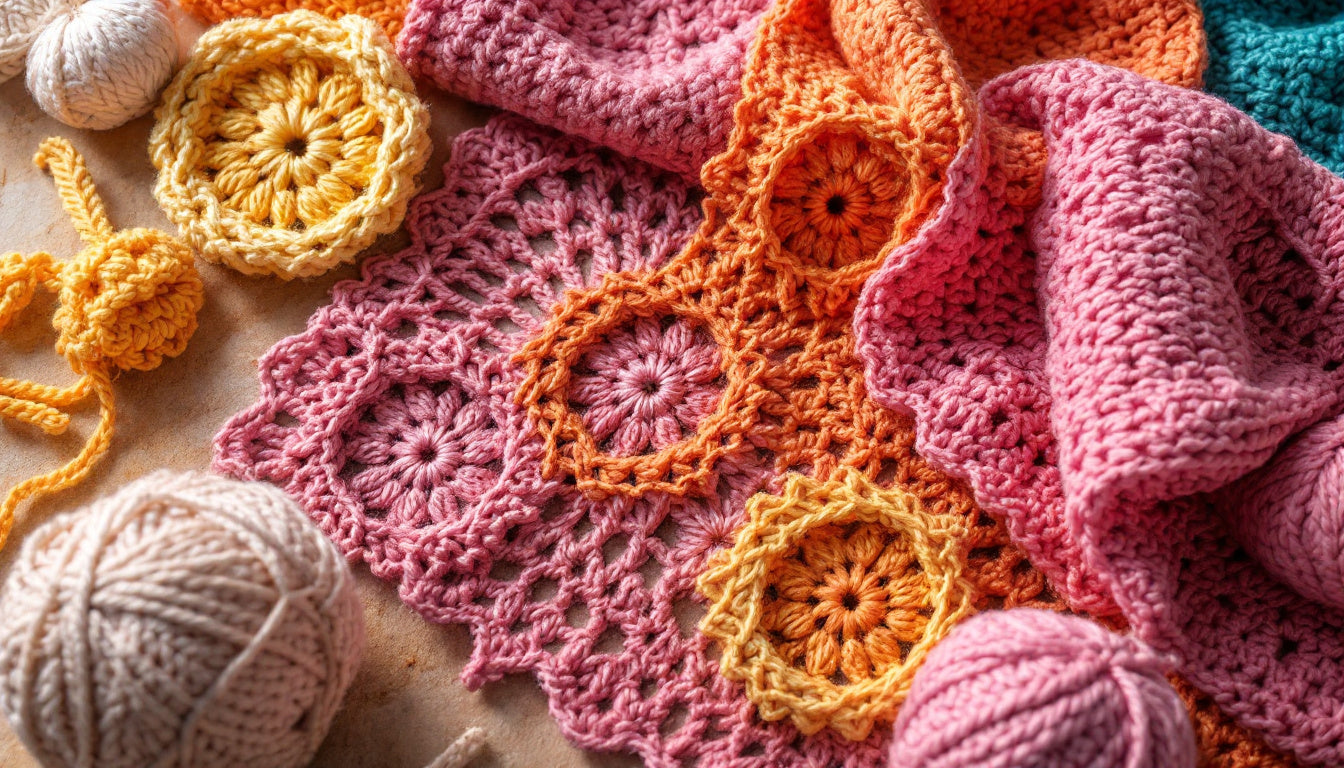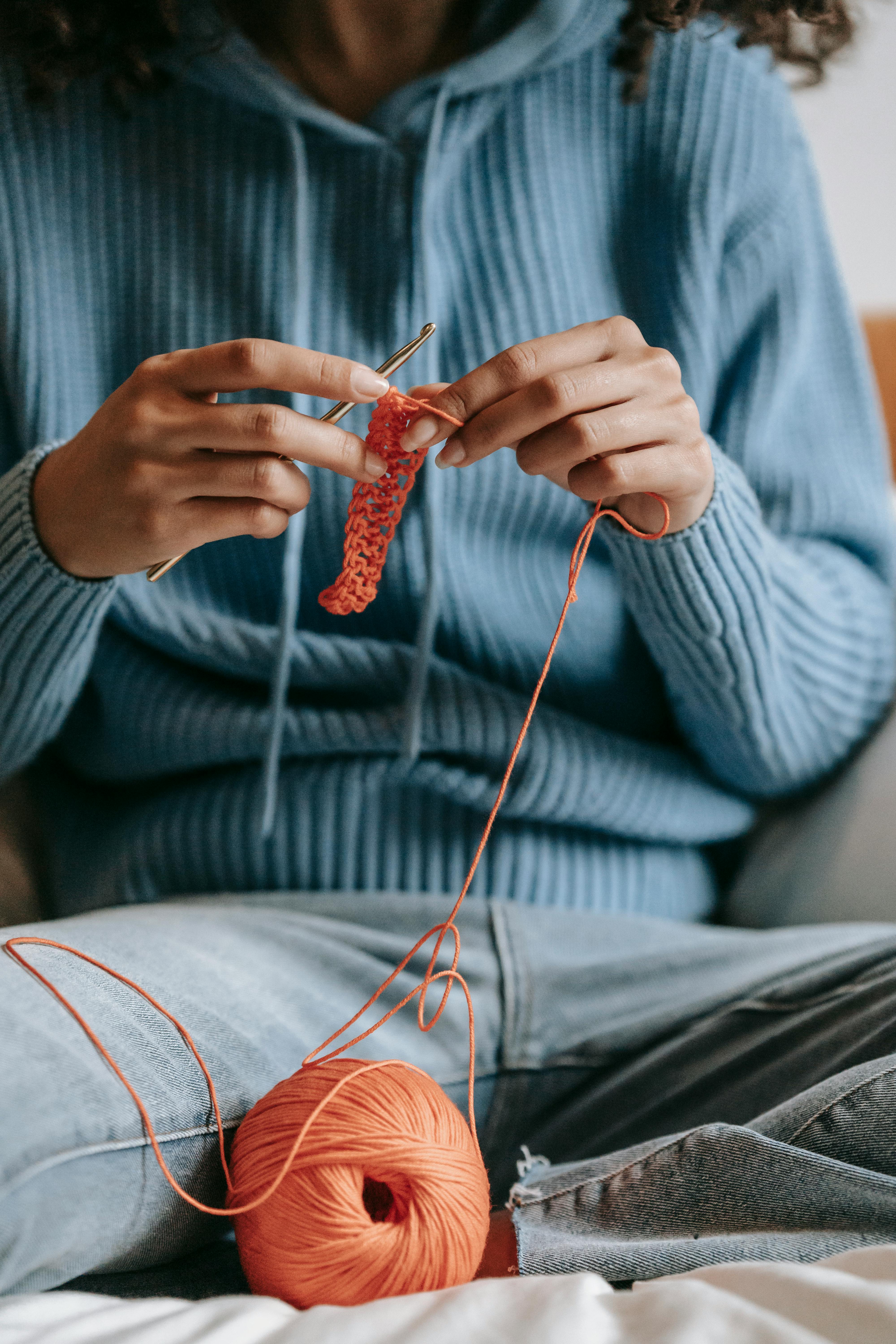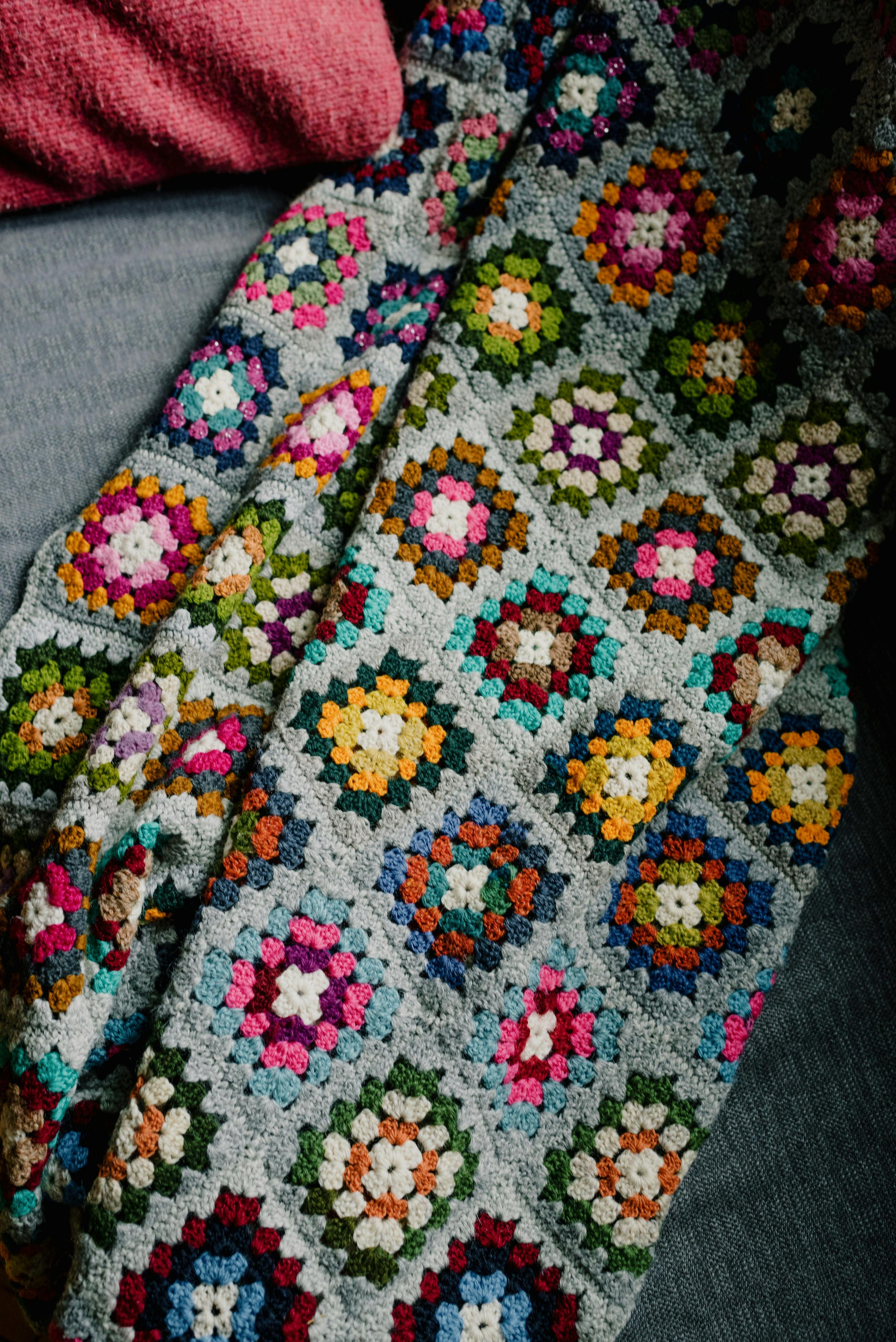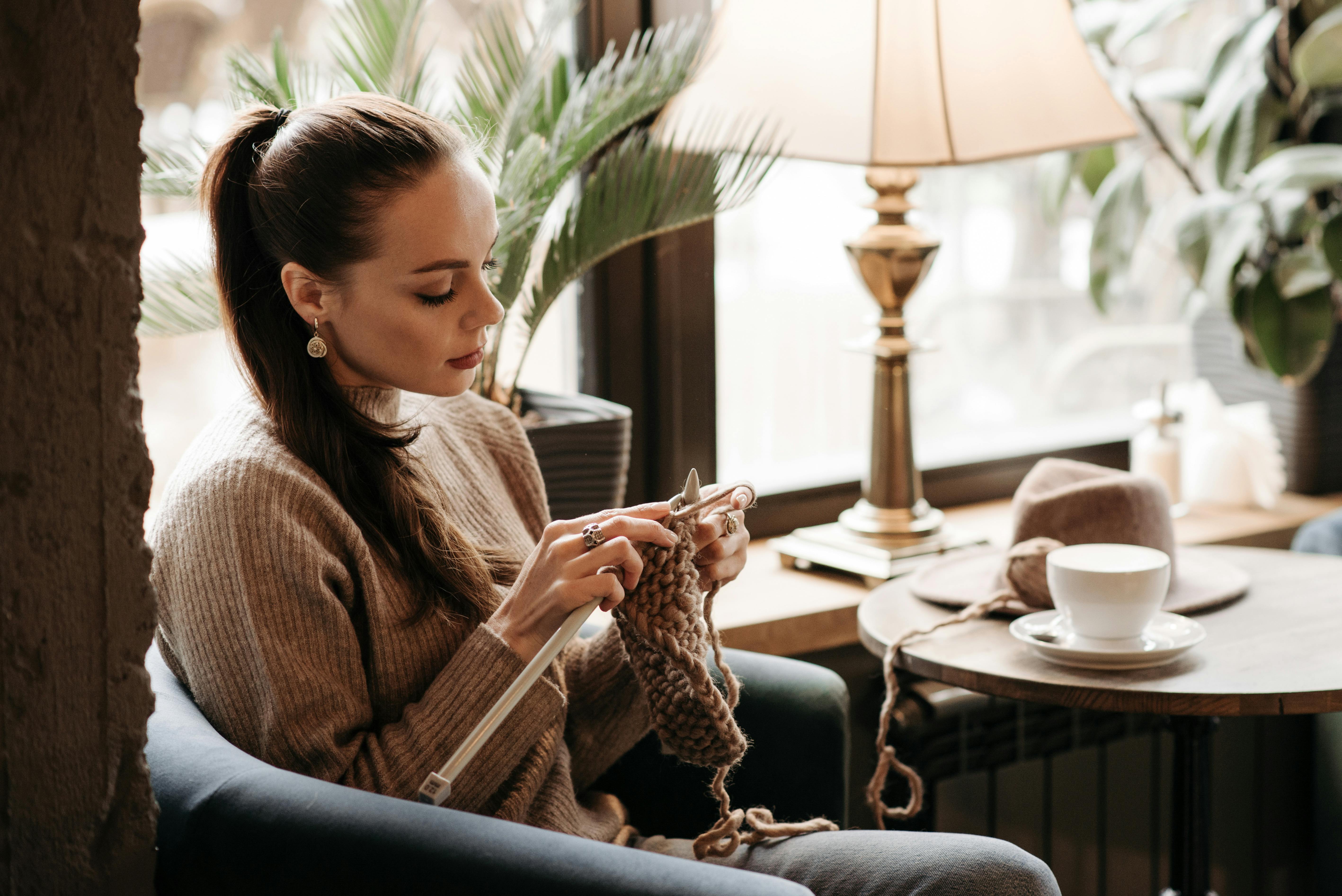
The Rise of Crochet: From Traditional Craft to a Modern Must-Have Trend
Crochet isn't just a pastime—it's a testament to creativity and tradition. Over the past few years, it's captured the spotlight, appealing to people of all ages and skill levels. The beauty of crochet lies in its flexibility; from cozy blankets to stylish wearables, the possibilities are endless. Its resurgence today points to a growing appreciation for handmade crafts and the stories woven into every stitch. If you're new to this world, check out some easy crochet projects to get started.
The Roots of Crochet
Crochet has a rich and fascinating history, interwoven with human creativity and resourcefulness. Understanding its roots provides greater appreciation for this timeless craft that continues to inspire people today.
Crochet’s Historical Beginnings

Photo by Castorly Stock
While crochet as we know it today emerged in the 19th century, its exact origins remain a topic of debate. Some historians link the technique to an even older art form: lace-making. Others argue that ancient methods from regions like China or Turkey closely resemble crochet. In essence, crochet evolved as a more accessible alternative to intricate lace designs, often requiring fewer tools.
A fascinating theory suggests that people used early forms of crochet to mimic more expensive lace, making it a functional skill for lower-income families. By the mid-1800s, it had gained popularity across Europe as a decorative yet practical craft for household items, garments, and accessories. For more on the global influence of crochet across eras, check out this detailed timeline of its history.
Early Patterns and Techniques
The first published crochet patterns appeared in the early 19th century, primarily within European magazines. These patterns were initially sparse and intended for advanced artisans. Unlike today’s detailed step-by-step guides, they assumed readers had significant prior experience. Common designs included delicate, ornamental motifs for doilies and edgings.
As crochet evolved, publications began introducing elementary patterns to welcome beginners into the craft. By 1840, books like "Beeton’s Book of Needlework" offered a variety of patterns ranging from home decor to clothing. It's incredible to think that terms like "chain stitch” and “double crochet” have been passed down for generations, remaining largely unchanged. If you'd like to explore some modern beginner patterns inspired by crochet's history, check out this beginner's guide to crochet trends.
The patterns and techniques of this era laid the foundation for all the amazing projects we enjoy today. Yet every stitch carries a piece of history, connecting us to a time when crochet was both an art and necessity.
Crochet in the Victorian Era
The Victorian era marked a transformative time for crochet, turning it from a functional technique into a fashionable form of self-expression. It was a time when handmade craftsmanship flourished, and crochet became a symbol of both creativity and social standing.
Printed Patterns and Instruction Books

Photo by Shuxuan Cao
During the 19th century, the publication of crochet patterns and instruction books revolutionized how the craft was shared. Before this era, crochet knowledge was primarily passed down orally, from one generation to the next. With the introduction of printed materials, crochet became accessible to a broader audience.
Magazines like "Penelope" and English manuals of the 1840s began including crochet patterns, inspiring women of the time to try their hands at creating delicate lace and intricate designs. Here’s a more in-depth look at Victorian publications and their patterns. These early patterns were often complex and challenging, but they sparked creativity and innovation in stitching techniques.
Books, such as "Beeton’s Book of Needlework," were renowned for gathering a variety of patterns into one resource, from doilies to decorative household pieces. These publications not only taught crochet but also elevated it as an art form celebrated within Victorian households. If you're curious about detailed historical patterns, take a look at some crochet templates inspired by vintage designs.
Instruction books didn’t just guide crocheters; they encouraged self-taught skills, making crochet a personal yet community-driven activity. Imagine the excitement of discovering new techniques in print—a small window into the creative possibilities of yarn.
Irish Crochet and its Influence
Another hallmark of the Victorian era was the rise of Irish crochet. This style was not only aesthetically unique but also deeply significant in history. Irish crochet emerged during the Great Irish Famine (1845-1852) as a source of income for struggling families. It became a way for women to contribute financially, turning craft into survival. For an overview of how Irish crochet patterns were meticulously constructed, you can read this guide about Irish crochet’s role in history.
The intricate motifs and lacy designs often mimicked the appearance of Venetian lace, but Irish crochet had its own distinct charm. The patterns featured raised flowers, leaves, and spirals, all connected by a delicate netting. Its versatility extended to garments, accessories, and ornamental pieces, making it a staple in Victorian fashion.
The impact of Irish crochet didn’t just end with practicality. It influenced broader European crochet styles, embedding a sense of artistry. The designs symbolized the resilience and creativity of the Irish people, a legacy that carries on in crochet circles today.
Whether replicated in modern pieces or studied in archival texts, the beauty of Irish crochet speaks volumes about the Victorian era’s essence: marrying form and function while telling stories in every thread. If you'd like to try creating your own modern spin on these vintage techniques, check out this easy collection of patterns.
The Victorian era elevated crochet from a practical skill to a celebrated art form. From its intricately published patterns to the resilience woven into Irish designs, this period made crochet an enduring piece of cultural heritage.
The Flower Power Resurgence
Crochet has seen many iconic moments, but the Flower Power movement in the 1960s and '70s sparked some of its most enduring trends. The burst of creativity during this era brought bold colors and expressive styles to the forefront, turning a traditional craft into a canvas for individuality and rebellion.
Granny Squares and Bold Colors

Photo by Anh Nguyen
During the hippie era, granny squares reached peak popularity. These patchwork-like motifs embodied freedom and self-expression, made from mismatched yarns in a kaleidoscope of colors. Unlike the subdued Victorian palettes, the 1960s and '70s embraced psychedelic shades that radiated happiness and energy. Want to learn how to make one yourself? Check out this step-by-step guide to granny squares.
Granny squares were more than just a crochet classic. They were symbols of togetherness. Each square could be made individually, connecting like puzzle pieces into blankets, tops, and even bags. People would often combine their efforts in communal crochet projects, creating items that were as much about the process as they were the product. Their modular beauty still inspires today’s trends—you can browse some modern takes in this collection of granny square patterns.
Crochet in Counter-Culture Fashion
Crochet became a hallmark of counter-culture fashion, synonymous with the free-spirited ethos of the hippie generation. It was a bold pivot from mass-produced clothing toward handmade, one-of-a-kind creations. By turning to crochet, people rejected factory lines and embraced creativity. Think of it like customizing your own playlist in an era of radio—personal, unique, and meaningful.
Crochet garments pushed boundaries: fringed vests, flowing skirts, and bohemian-inspired tops graced festivals and protests alike. They carried a message of self-reliance and individuality—a wearable form of resistance. For a deep dive into how crochet and fashion intersect, explore this Crochet Clothing Collection.
Today, the influence of Flower Power can be seen in the resurgence of retro styles. Modern crochet artists continue to blend iconic designs with updated techniques, creating perfect hybrids of vintage charm and contemporary flair. If you'd like to try a playful throwback pattern, the Flower Power Square is an excellent place to start—a fun nod to this vibrant era.
Modern Revival of Crochet
Crochet is no longer just a cherished tradition; it's become a full-fledged movement. From social media-driven trends to high-fashion runways, the craft has cemented its place in modern culture. The renaissance we're seeing today is redefining crochet as chic, accessible, and community-driven.
The Role of Social Media

Photo by Ahshea1 Media
Platforms like TikTok, Instagram, and Pinterest have breathed new life into crochet. Eye-catching reels showcasing the mesmerizing rhythm of loops and stitches have captivated a new generation. Have you noticed how satisfying it is to watch a granny square take shape in seconds? That's the virality that crochet enjoys online.
TikTok, particularly, is buzzing with Gen Z creators showcasing crochet tops, bags, and trendy accessories. It's become a cultural phenomenon. You can check platforms like Woke Waves’ Gen Z Crochet Mania to see how young creatives are reinterpreting traditional techniques.
Even Pinterest boards are filled with crochet inspiration, helping beginners and pros alike. Online visuals make it easier to learn, discover trends, and purchase patterns or tutorials instantly. Crochet has become as much about expression as it is about creation, with platforms encouraging everyone to pick up a hook.
Celebrities and Mainstream Appeal
Celebrities have played a significant role in putting crochet in the spotlight. Stars like Zendaya and Harry Styles have embraced crochet as part of their wardrobe, proving its versatility and appeal in modern fashion. Do you remember Styles' iconic patchwork crochet cardigan? It went viral, inspiring countless fans to recreate similar pieces, sparking trends like #HarryStylesCardigan on social media.
Crochet is no longer reserved for bohemian aesthetics either; it's being elevated by high-end designers. Luxury brands such as Gucci and Dior have showcased crochet-inspired designs on the runway, merging hand-craftsmanship with couture. Articles like Is Crochet Gaining Popularity? highlight how the craft perfectly aligns with the current obsession with slow fashion and sustainability.
By bridging nostalgia and innovation, crochet has transformed into a statement of individuality and environmental consciousness. The widespread popularity among celebrities ensures that it doesn't fade away anytime soon.
Growing Online Communities
The rise of online crochet communities is a game-changer for making this craft more accessible to everyone. Facebook groups, Reddit threads, and YouTube channels have become treasure troves for beginners and experts alike. It's like having a personal mentor at your fingertips.
For instance, The Secret Yarnery’s blog, Easy Crochet Projects for Beginners: Start Today!, offers helpful insights for anyone just starting. Resources like these let you explore simple patterns but also connect with a supportive community sharing the same passion.
YouTube creators also play a huge role in demystifying crochet. Whether you're trying to master a beginner’s chain stitch or dive into advanced designs, there’s a tutorial for everything. Tutorials don’t just teach; they motivate. Think of them as a virtual crochet circle where you can pause and replay until you've nailed that tricky stitch.
Through these communities, crochet becomes a shared experience. It’s more than just a craft—it's a connection. Whether you contribute your creations or enjoy the camaraderie of others, the sense of belonging keeps the crochet revival alive.
Sustainability and Handmade Fashion
Crochet isn't just a therapeutic hobby; it's also a powerful tool for embracing a sustainable lifestyle. With fast fashion taking an environmental toll, crochet offers a handmade alternative that values creativity, individuality, and eco-consciousness.
Crochet and Eco-Friendly Trends

Photo by Miriam Alonso
Crochet aligns perfectly with today's sustainability efforts. Think about it: creating something with your own hands slows down consumption and reduces demand for mass-produced items. Many crocheters are turning to eco-friendly yarns made from organic cotton, bamboo, and even recycled materials. Some also upcycle old textile scraps into chic new designs, giving items a second life and reducing waste.
Additionally, handmade crafts like crochet are an antidote to the throwaway mentality of fast fashion. Every stitch in a crochet project reflects time, care, and intention—qualities that are often missing in mass-produced apparel. If you're wondering how to incorporate crochet into your sustainable wardrobe, check out the Handmade Crochet Bandana Creations, which combine natural fibers with timeless design.
The next time you're choosing yarn, why not go for an eco-conscious option? Not only will your projects look amazing, but they'll also align with a planet-friendly lifestyle.
The Allure of Unique, Handmade Items
Handmade crochet items are virtually the polar opposite of what fast fashion stands for. Each piece carries a uniqueness that reflects the personality of its maker. In a world full of cookie-cutter clothing, owning something handmade feels like wearing a story rather than just an outfit.
Many people crave handmade goods because they represent authenticity. Fast fashion thrives on trends that come and go, flooding closets with generic styles. Crochet, on the other hand, offers timeless aesthetics that often become wardrobe staples. Take, for example, trendy accessories like crochet headscarves. They’re more than stylish—they're also functional and sustainable, as highlighted in the Handmade Bandanas guide.
Why do crochet pieces stand out so much? It’s simple: they’re designed with care and individuality. Unlike factory-made items, handmade creations feature thoughtful details, making them treasures instead of temporary buys. If you're making a gift or creating something for yourself, crafting with intention is far more fulfilling than scrolling through racks of mass-produced clothing.
For an even deeper dive into how handmade crochet supports ethical fashion trends, Rare & Fair offers incredible insights into the value of artisan pieces. Plus, when you buy handmade or make your own, you're contributing to a movement that values sustainability over excess.
Crochet isn't just craft—it's a meaningful, eco-conscious choice. What's stopping you from starting your next project?
Mastering Crochet for All Skill Levels
Crochet is one of those timeless crafts where there’s always something new to learn, no matter how long you’ve been at it. Whether you’re just starting or have been crocheting for years, there's always a pattern or technique waiting to inspire your next project. Let’s explore how beginners and advanced crocheters alike can dive deeper into the world of crochet.
Beginner-Friendly Patterns and Tutorials

Photo by Miriam Alonso
Starting out with crochet might feel intimidating, but it doesn’t have to be. Once you know a few basic stitches, the possibilities open up significantly. The key is to begin with simple patterns that allow you to build your skills while creating something tangible and rewarding.
Here are some beginner-friendly project ideas:
- Scarves: A straightforward pattern that’s perfect for practicing the foundation chain and single crochet stitches.
- Coasters: Small, quick to finish, and excellent for mastering different stitches.
- Washcloths: Functional and forgiving for minor errors, perfect for practice sessions.
If you're looking for step-by-step guidance, check out this comprehensive Easy Crochet Projects for Beginners resource. It’s filled with simple patterns that take you through every stitch, making the learning process stress-free and enjoyable.
For more inspiration, don’t miss this specially curated beginner's playlist on YouTube, Crochet Projects for Absolute Beginners. You'll find video tutorials that break down techniques in an easy-to-follow way, perfect if you learn best through visual aids.
Expanding Techniques for Advanced Crafters
If you’ve already mastered the basics, why not push your skillset to the next level with more intricate designs? Advanced crochet is all about experimenting with new techniques and challenging yourself creatively. Tapestry crochet, for instance, is perfect for those looking to elevate their projects with vibrant, multicolored patterns.
Here are some advanced techniques to try:
- Tapestry Crochet: Create stunning, colorful designs by working with multiple strands of yarn simultaneously.
- Cabled Crochet: Add texture and depth to your projects reminiscent of traditional knitted cables.
- Mandala Crochet: Dive into decorative art pieces that range between intricate wall hangings and functional rugs.
Advanced crocheters might enjoy exploring a collection of techniques offered on the Exploring Crochet Stitches: From Basic to Advanced guide. It’s perfect for refining your skills and experimenting with more challenging stitches.
If you prefer learning through video, Advanced Crochet Stitches provides a playlist of intricate patterns that will keep you engaged for hours. From cluster stitches to wrap-around designs, this playlist is brimming with creative inspiration.
The magic of crochet is that you never really “finish” learning—there’s always another stitch or pattern just waiting to be discovered. Whether you're just starting out or you're deep into experimenting with technical designs, crochet has something for everyone.
Conclusion
Crochet continues to thrive, evolving from a heritage craft to a creative expression that resonates across generations. Its place in history and culture reflects a deep connection between art, functionality, and personal storytelling. The growing interest in crochet today, fueled by social media, sustainability, and fashion trends, highlights its timeless appeal and adaptability.
Whether you're a beginner or an expert, there’s always more to discover. From modern patterns to vintage-inspired designs, the possibilities are truly endless. For inspiration and guidance on your crochet journey, start with some beginner-friendly crochet patterns.
What will you create next? Let your hands and imagination lead the way as crochet continues to weave its way into our lives, blending tradition with modern creativity.
Frequently Asked Questions
1. What is crochet, and how is it different from knitting?
Crochet is a craft using a hooked tool (called a crochet hook) to create fabric by interlocking loops of yarn, thread, or other materials. Unlike knitting, which uses two needles and multiple live stitches, crochet works with a single hook and one loop on the tool at any time, making it easier to manage and less likely to unravel.
2. Can anyone learn to crochet?
Yes! Crochet is one of the most beginner-friendly crafts. With simple tools, a little patience, and easy-to-follow tutorials, people of all ages and skill levels can learn the basic stitches and start creating projects.
3. What are the basic supplies needed to start crocheting?
To start crocheting, you'll need:
- A crochet hook (size depends on your yarn/project).
- Yarn (start with worsted weight for beginners).
- Scissors.
- A tapestry needle for weaving in loose ends. Optional: Stitch markers and a measuring tape are handy for more advanced projects.
4. How long does it take to learn crochet?
Learning the basics, like chain stitches and single crochet, can be done in a day! Building confidence and mastering more intricate patterns may take a few weeks to months, depending on practice. The key is consistency.
5. What are some easy beginner projects?
Beginner projects include:
- Scarves
- Coasters
- Dishcloths
- Simple headbands These projects require basic stitches like chains, single crochet, and possibly double crochet.
6. Is crochet an expensive craft?
Crochet can be as affordable or premium as you want. Basic supplies (a hook and yarn) are inexpensive, and there are plenty of free online tutorials. However, specialty yarns and advanced patterns may increase costs.
7. What are some common stitches in crochet?
Some common stitches include:
- Chain (ch)
- Single crochet (sc)
- Double crochet (dc)
- Half double crochet (hdc)
- Slip stitch (sl st) These stitches form the foundation of most crochet patterns.
8. What is the difference between UK and US crochet terms?
The same stitch names mean different things in UK and US patterns. For example, a "double crochet" in US terms is called a "treble crochet" in the UK. Always check the pattern’s terminology before starting.
9. How can I fix mistakes while crocheting?
One common way to fix mistakes is "frogging" (undoing stitches) and reworking the problem area. Simply pull the yarn back to the error point and crochet forward again. Video tutorials on YouTube help guide you through common fixes.
10. What types of yarn are best for crochet beginners?
Worsted-weight yarns in smooth, solid colors are ideal for beginners. Cotton or acrylic options are great for practice as they’re durable and easy to work with. Avoid novelty or fuzzy yarns until you’re more experienced.
11. Why is crochet popular again?
Crochet has made a comeback due to social media trends, sustainability efforts, and its appearance in modern fashion. The DIY aspect appeals to people who love creating unique, handmade items.
12. How can I make my crochet projects last longer?
To ensure durability:
- Use high-quality yarn suited for the project.
- Follow washing and care instructions on the yarn label.
- Always securely weave in loose ends when finishing your work.
13. Can crochet help reduce stress?
Yes! Crochet is known to be a therapeutic activity. Its repetitive motions can help reduce anxiety, improve focus, and provide a sense of accomplishment.
14. Are there resources for left-handed crocheters?
Absolutely! Many tutorials and pattern adjustments are designed for left-handed crocheters. YouTube channels like "The Crochet Crowd" and blogs often include left-hand versions.
15. Where can I find free crochet patterns?
You can find free patterns on websites like:
- Ravelry
- The Secret Yarnery
- LoveCrafts
- Yarnspirations Many creators also share patterns on their blogs and YouTube channels.

Christa Patel is a passionate crochet enthusiast, designer, and writer who has been creating and sharing her love for this timeless craft for over a decade. With roots in heritage crafting and a deep appreciation for sustainability, Christa brings a modern twist to traditional crochet techniques. Her work celebrates the artistry and history behind every stitch while inspiring beginners and seasoned crafters alike to explore their creativity.
Christa's journey began during college when she discovered the therapeutic and rewarding nature of crochet. What started as a hobby quickly turned into a lifelong passion. Today, she runs a popular blog where she shares easy-to-follow tutorials, historical insights, and creative project ideas. Christa's designs often fuse vintage charm with contemporary trends, showing how versatile and relevant crochet can be in today’s world.
When she's not crocheting, Christa enjoys connecting with fellow yarn lovers through workshops, social media communities, and local events. Her mission is to empower people to create handmade items that are not only beautiful but also meaningful and sustainable.
You can explore her latest patterns, tips, and stories at The Secret Yarnery. Whether you're just discovering crochet or looking to dive into new challenges, Christa's welcoming approach makes every project feel achievable and fun.

